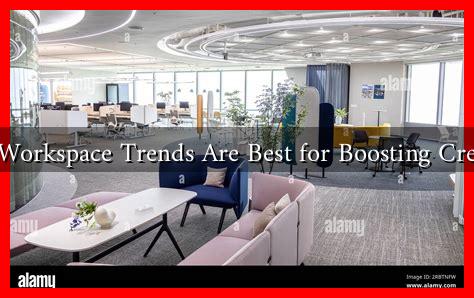-
Table of Contents
What Workspace Trends Are Best for Boosting Creativity
In today’s fast-paced and ever-evolving work environment, fostering creativity is more crucial than ever. As organizations strive to innovate and stay competitive, understanding the workspace trends that can enhance creative thinking is essential. This article explores various trends that have been shown to boost creativity in the workplace, supported by research, case studies, and practical examples.
The Rise of Flexible Workspaces
One of the most significant trends in modern workspaces is the shift towards flexibility. Flexible workspaces allow employees to choose where and how they work, which can lead to increased creativity. According to a study by the Harvard Business Review, employees who have the freedom to choose their work environment report higher levels of job satisfaction and creativity.
- Open-Plan Offices: These spaces encourage collaboration and communication among team members. Companies like Google and Facebook have adopted open-plan designs to foster a culture of innovation.
- Co-Working Spaces: Co-working spaces provide a dynamic environment where individuals from different industries can collaborate. Research from Deskmag shows that 71% of co-workers feel more creative than when working in a traditional office.
Incorporating Nature into the Workspace
Biophilic design, which integrates natural elements into the workspace, has gained traction as a means to enhance creativity. Studies have shown that exposure to nature can reduce stress and improve cognitive function, leading to more innovative thinking.
- Indoor Plants: Adding greenery to the office can improve air quality and boost mood. A study by the University of Exeter found that employees in green offices were 15% more productive.
- Natural Light: Maximizing natural light in the workspace can enhance focus and creativity. A report from the World Green Building Council indicates that access to natural light can improve employee well-being and productivity.
Technology-Driven Collaboration Tools
As remote work becomes more prevalent, technology plays a vital role in fostering creativity. Collaboration tools enable teams to brainstorm and share ideas seamlessly, regardless of their physical location.
- Virtual Whiteboards: Tools like Miro and MURAL allow teams to visualize their ideas in real-time, making brainstorming sessions more interactive and engaging.
- Project Management Software: Platforms like Trello and Asana help teams organize their tasks and ideas, ensuring that creative projects stay on track.
Encouraging a Culture of Experimentation
Organizations that promote a culture of experimentation and risk-taking often see higher levels of creativity. When employees feel safe to share their ideas without fear of failure, they are more likely to innovate.
- Hackathons: Companies like Spotify and Facebook host hackathons to encourage employees to work on creative projects outside their usual responsibilities.
- Feedback Loops: Establishing regular feedback sessions can help employees refine their ideas and feel more confident in their creative pursuits.
Case Studies: Companies Leading the Way
Several companies have successfully implemented these trends to boost creativity within their teams:
- Google: Known for its open office spaces and emphasis on collaboration, Google encourages employees to spend 20% of their time on personal projects, leading to innovations like Gmail and Google News.
- Airbnb: The company’s headquarters features a design that incorporates natural elements and flexible workspaces, fostering a culture of creativity and collaboration.
Conclusion
As the workplace continues to evolve, embracing trends that enhance creativity is essential for organizations aiming to thrive in a competitive landscape. Flexible workspaces, biophilic design, technology-driven collaboration tools, and a culture of experimentation are all effective strategies for boosting creativity. By investing in these trends, companies can create an environment that not only inspires innovation but also enhances employee satisfaction and productivity.
In summary, the key takeaways for boosting creativity in the workplace include:
- Adopting flexible workspaces that encourage collaboration.
- Incorporating natural elements to improve well-being.
- Utilizing technology to facilitate creative collaboration.
- Fostering a culture of experimentation and risk-taking.
By implementing these strategies, organizations can unlock the creative potential of their teams and drive innovation forward.
For further insights on workplace trends, you can explore resources from the Harvard Business Review.

